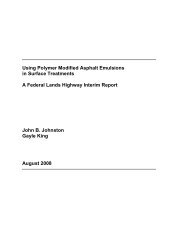Handbook for Bridge Inspections - TSP2
Handbook for Bridge Inspections - TSP2
Handbook for Bridge Inspections - TSP2
You also want an ePaper? Increase the reach of your titles
YUMPU automatically turns print PDFs into web optimized ePapers that Google loves.
For roads subject to salti ng spot checks of the chloride content<br />
should be taken in exposed areas such as pi llars supporting the<br />
approach sections to a bridge and the edge girders of bridges along<br />
the route. This is most va lid <strong>for</strong> bridges constructed according to<br />
older regulations, namely be<strong>for</strong>e 1996/97.<br />
Repeated chloride content measurements ought to be taken during<br />
each main inspection at approximately the same locations as a fol <br />
low-up over time. Measures can accordingly be taken timeously<br />
should the need arise.<br />
For new large coastal bridges inspection routines should be fo llowed<br />
or establi shed if necessary.<br />
Spot tests should be carried out on older bridges which have not<br />
previously been chec ked <strong>for</strong> chloride incursion. The need <strong>for</strong> a<br />
special inspection incorporating more extensive materials tests<br />
should be assessed.<br />
Measurements of the covering and the depth of any carbonisation<br />
should be undertaken at the sa me time as any dri lling <strong>for</strong> dust in<br />
connection with chloride tests. Alternatively a special inspection<br />
can be carri ed out including comprehensive materials testing and,<br />
if necessary, EC P measurements.<br />
Special <strong>Inspections</strong><br />
Chloride measurements are carri ed out according to special prescriptions.<br />
Their extent and location should be taken into during<br />
execution of the test.<br />
Ad vantages and<br />
Disadvantages<br />
On site testing is cheap and easy to carry Oul but are less accurate<br />
than laboratory methods. Analyses conducted in a laboratory are<br />
time-consuming and costly but result in a high level of accurac<br />
7.3.4 Corrosion Testing (ECP)<br />
To measure the rein<strong>for</strong>cement's electrochemical potential (ECP)<br />
and associated resistance in order to assess the probability of the<br />
rein<strong>for</strong>cement co rroding.<br />
Procedures<br />
Reference is made to the National Publ ic Roads Administration<br />
<strong>Handbook</strong> No. 0 15: "On Site Testing", Method NO. 15.552 and the<br />
National Pub lic Roads Administration, <strong>Bridge</strong> Division's Report<br />
No. 94- 16 <strong>Bridge</strong>s:<br />
"Recommendations <strong>for</strong> the Equipment <strong>for</strong> Measuring<br />
Electrochemical Potential (ECP)".<br />
General<br />
Scope<br />
ECP measurements should be taken if latent rein <strong>for</strong>cement corrosion<br />
is suspected.
















